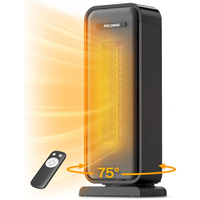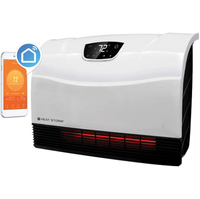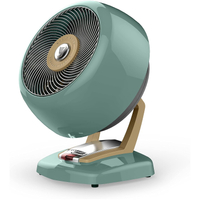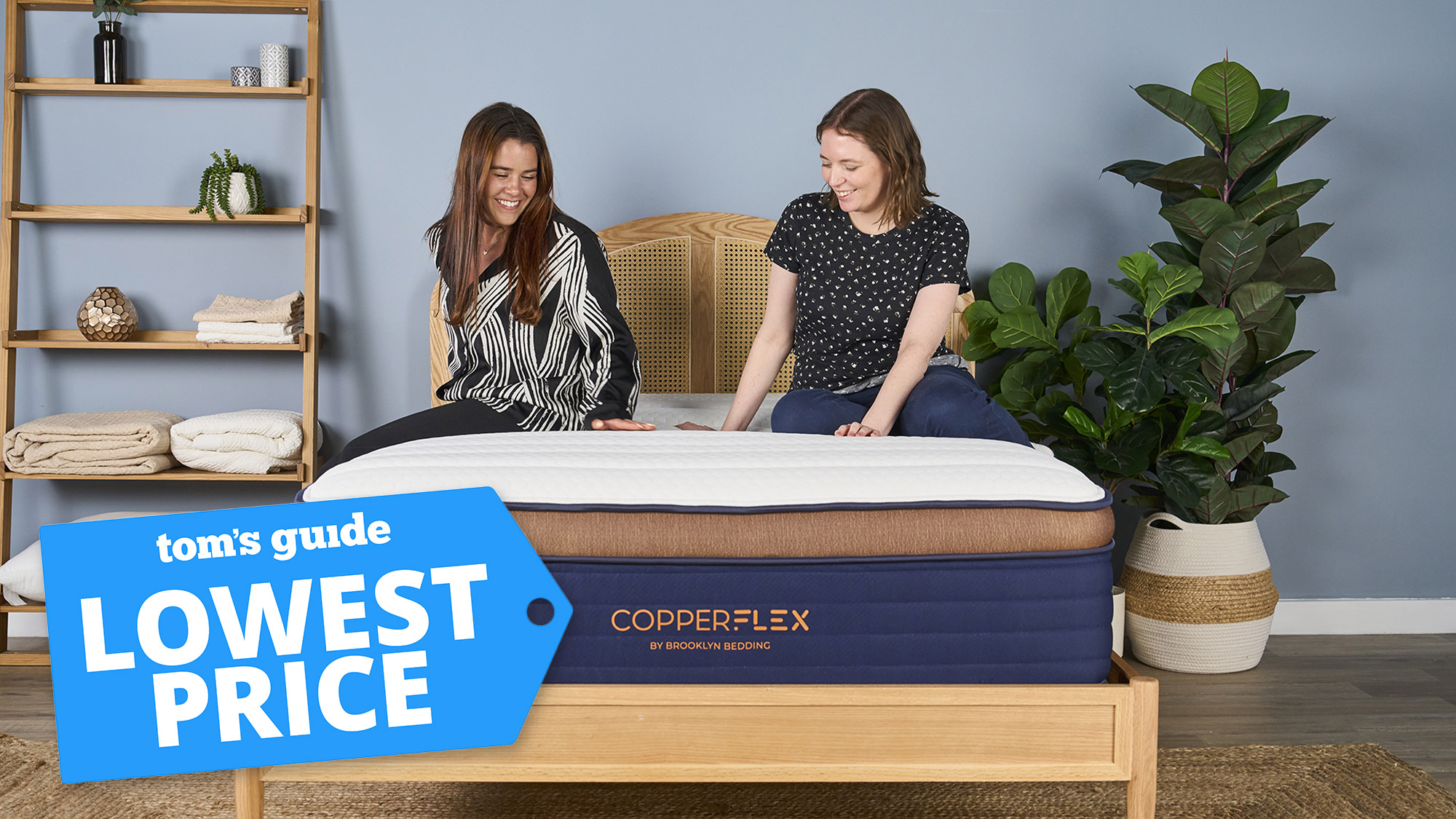Best space heaters in 2025 — expert tested and rated
Here are the best space heaters to keep you toasty all year round
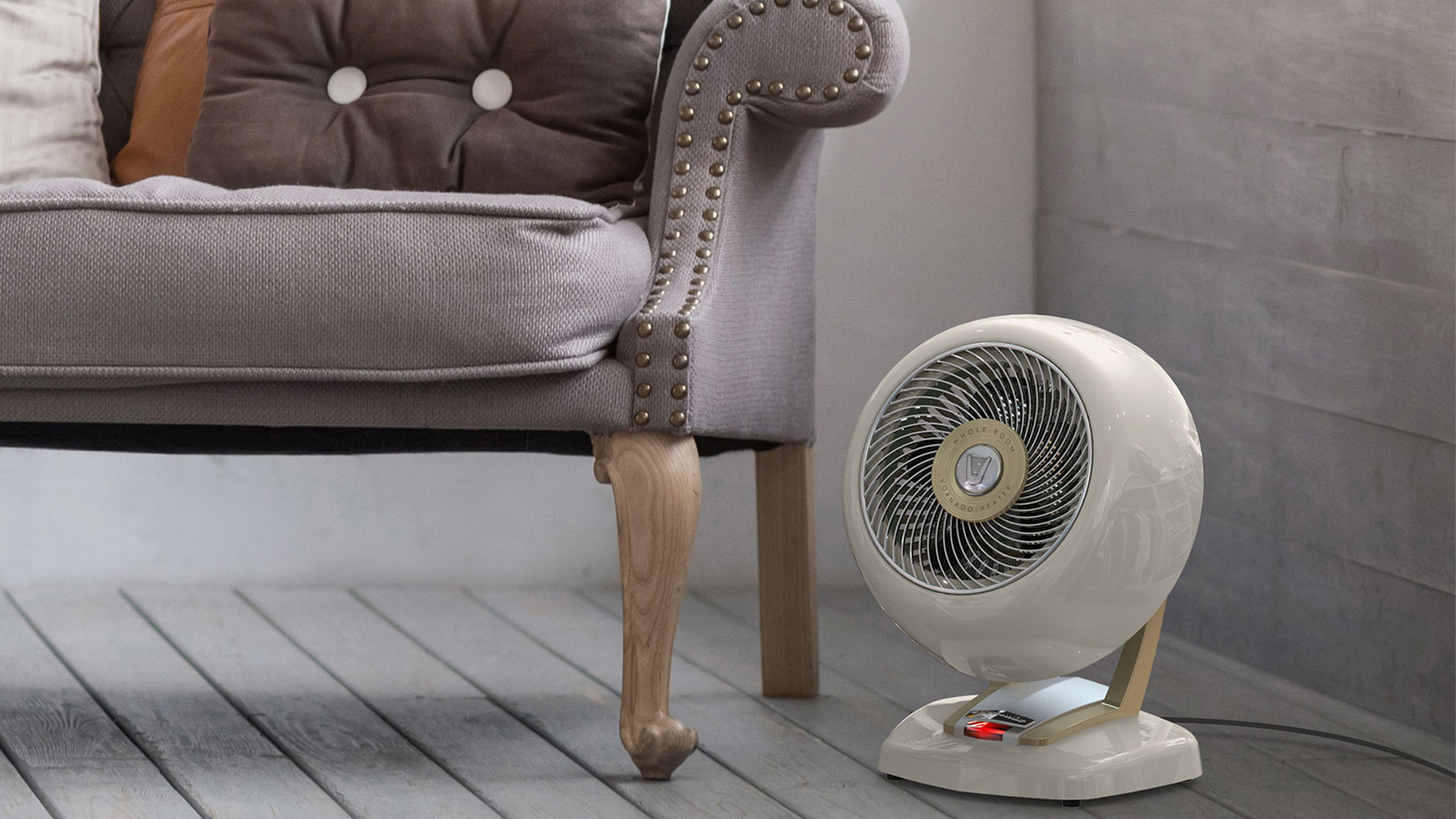
The best space heaters are an efficient way to heat up cold rooms. Instead of heating a whole home, you plug in the heater and warm a specific space or just point a compact model at yourself for some quick heat.
Since it's hard to know how they fare until they're in your home, we put the best space heaters to the test, checking the effectiveness and efficiency of each model. That's how we landed on the Lasko FH500 as the top choice for most people.
It quickly heats up your space, has a reliable remote, and isn't too noisy. Plus, it doubles as a tower fan for the summer. But if you're looking for a cheaper or smaller option, we recommend the Vornado VH200 Heater.
These aren't your only choices — we've tested and rated many models to help you find the best space heater for your home, office or indoor space.
The quick list
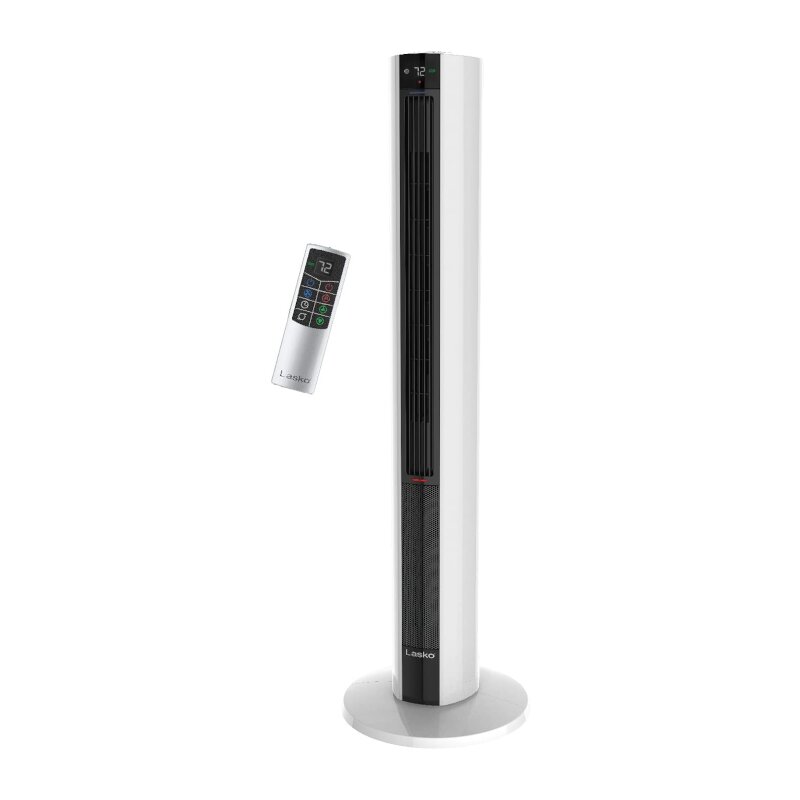
This is easily the best space heater for most rooms. It's a dual-use fan for summer and tower heater for winter. The unit warmed up our rooms effectively and efficiently, and has three heat settings, a digital thermostat and a reliable and easy to use remote.
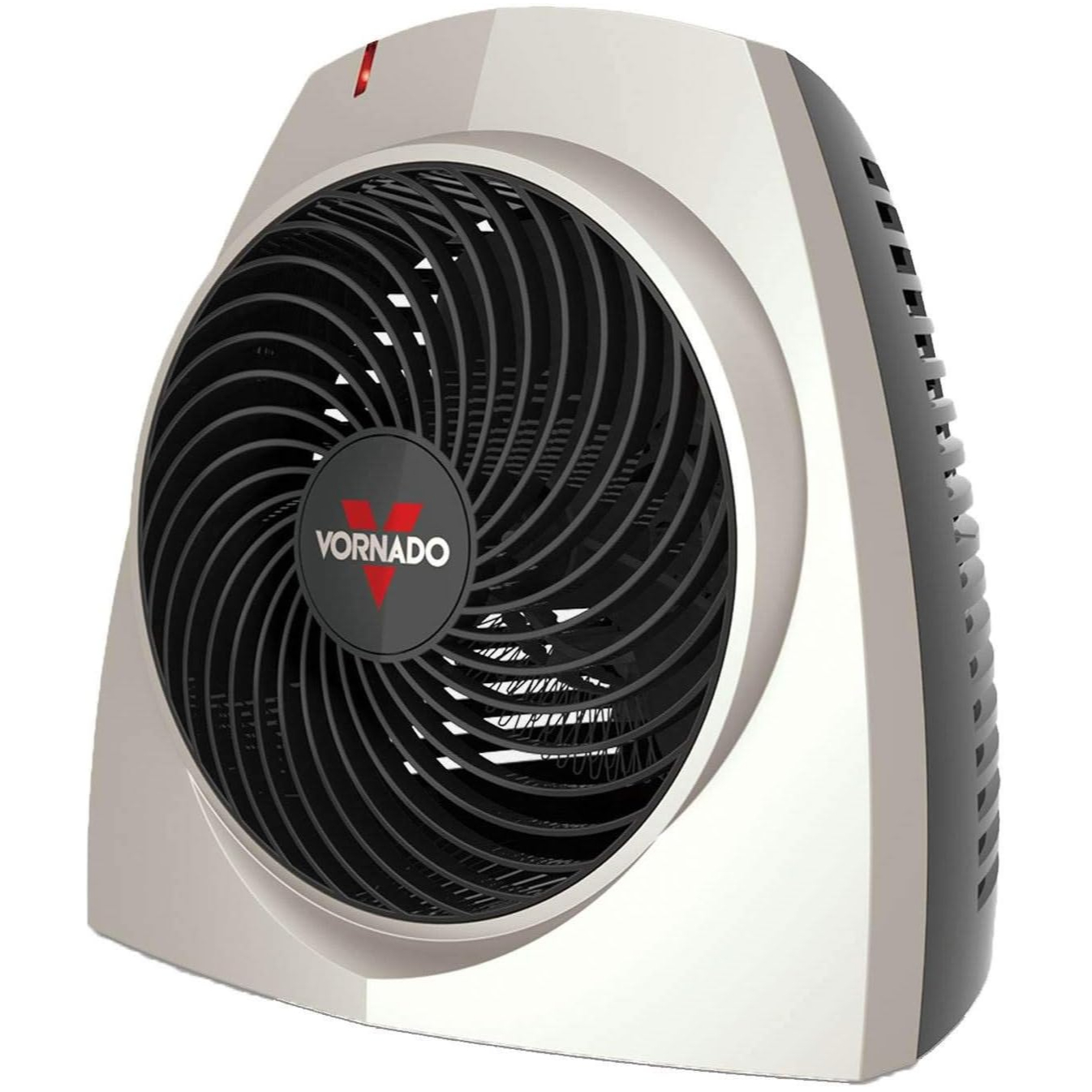
If you’re after an affordable heater, this is good value for money. Despite its compact design, it can effectively heat a room, and comes with three adjustable heat settings. It’s less obtrusive than some space heaters, and it’s quiet, which is always a bonus.
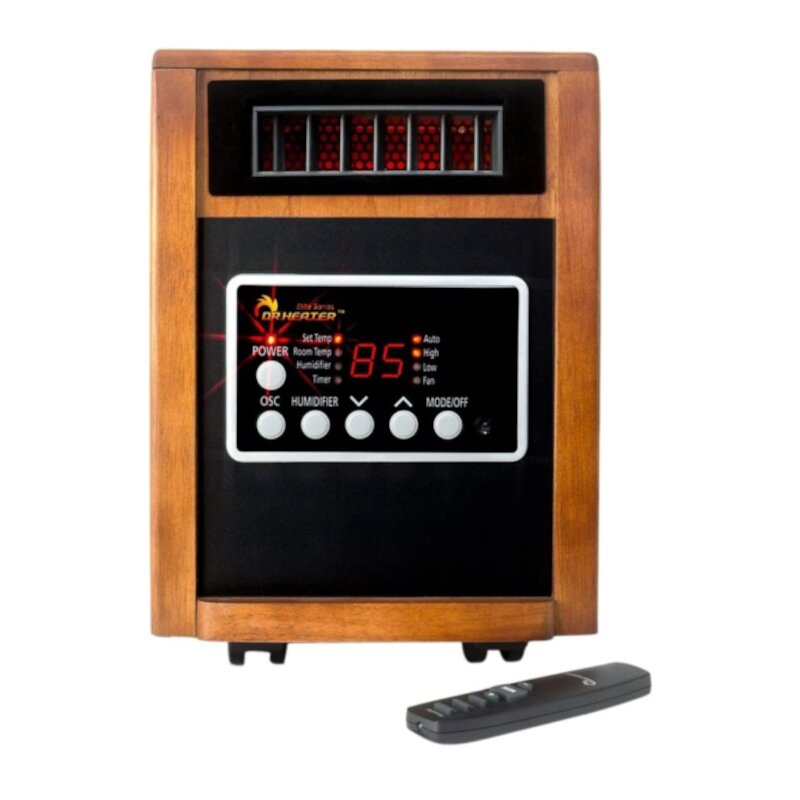
This retro-style, infrared heater is efficient and makes an attractive feature in any room. It’s powerful to heat up a large room and also doubles up as a humidifier. It comes with two settings, large LED display, and remote control.
The best space heaters you can buy right now
Why you can trust Tom's Guide
Best space heater overall
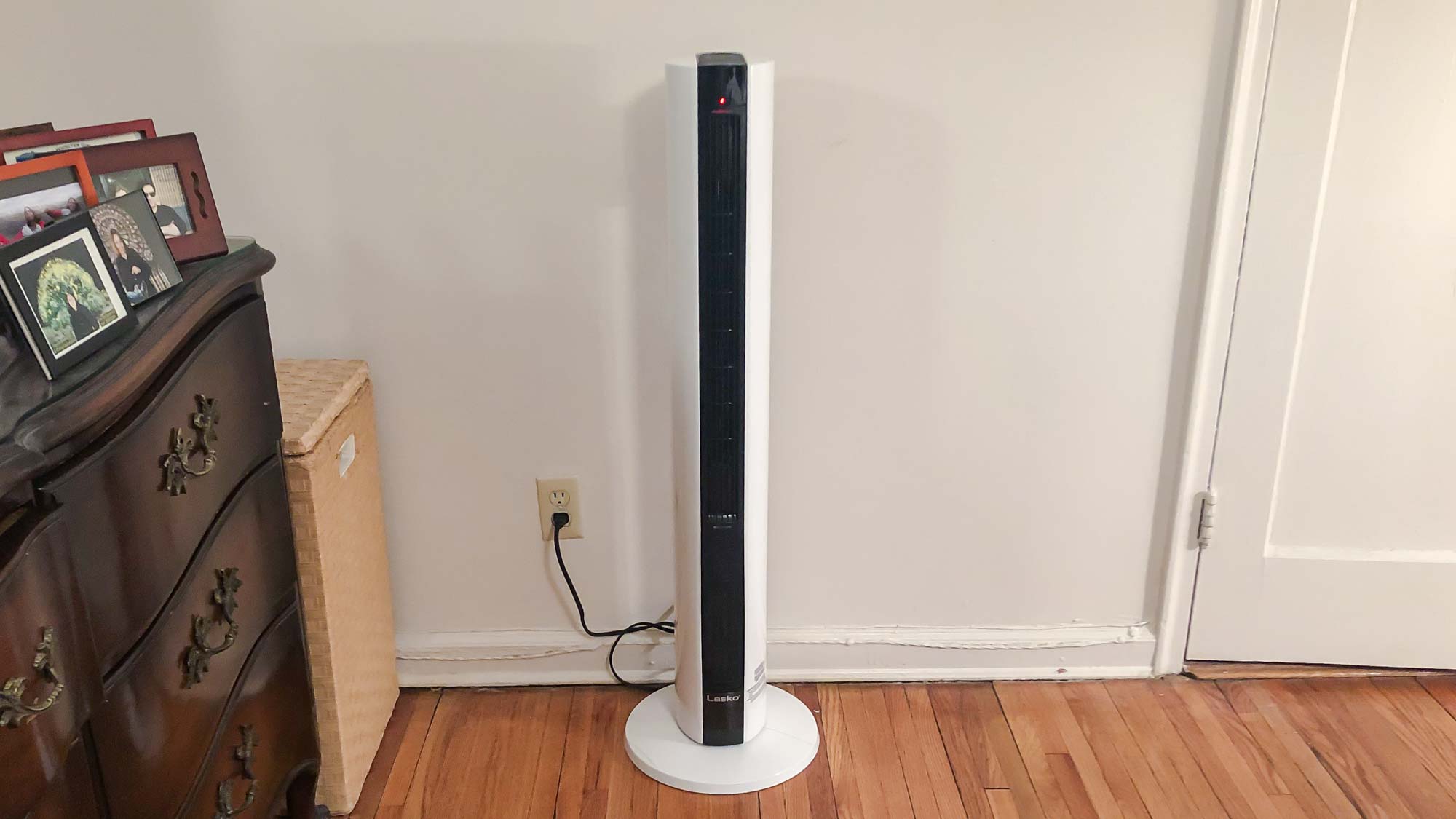
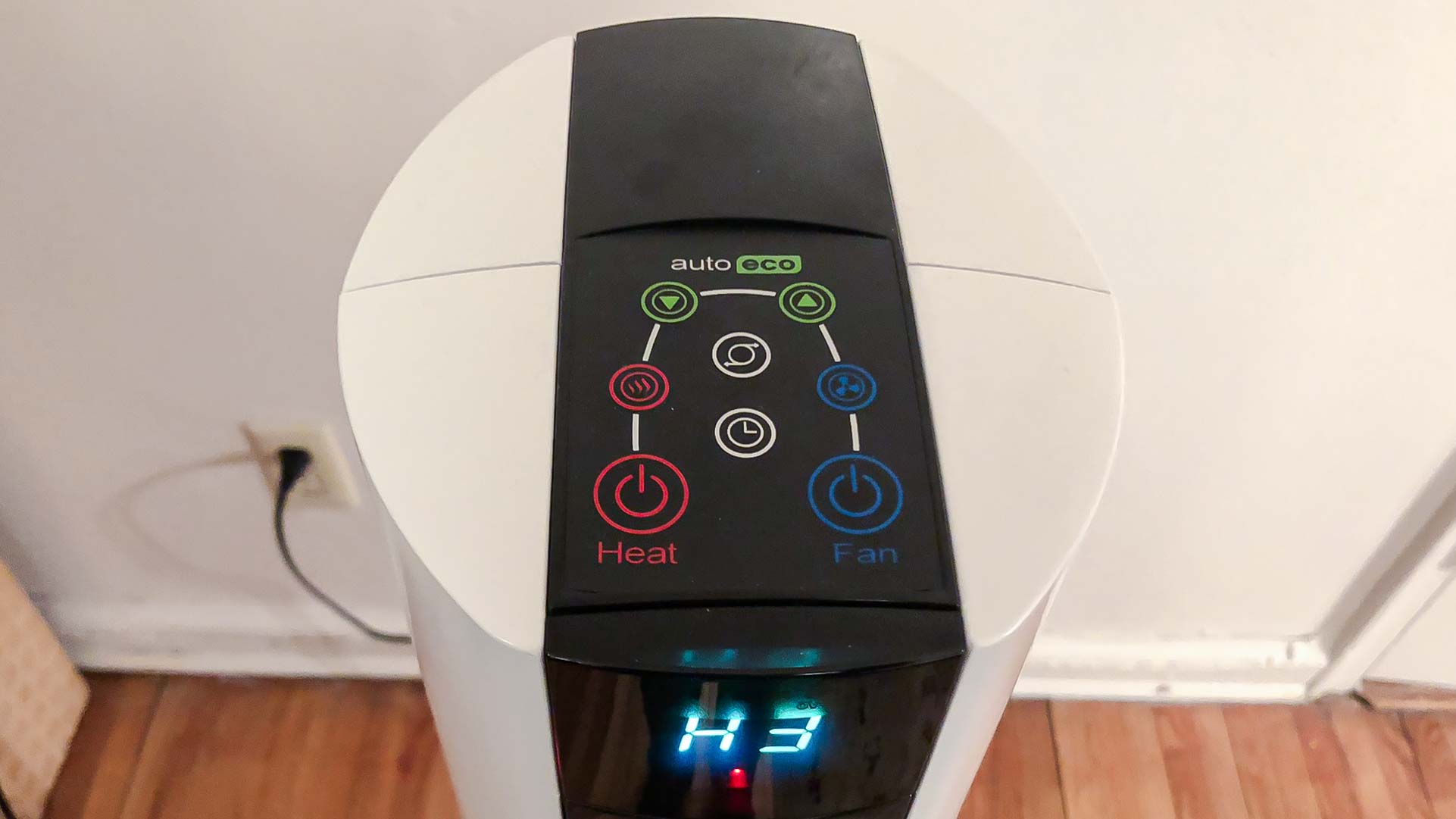
Specifications
Reasons to buy
Reasons to avoid
Although it’s over three feet tall, the Lasko FH500 is slim and has a clean, uncluttered design. In a 15 x 10 foot test room, at its highest setting, it surpassed every other heater we tested, and raised the temperature perfectly evenly by 10 degrees Fahrenheit.
It was also quick to heat up; within 12 seconds, we felt warmer. In spite of its great heat output, it drew an average amount of energy in relation to the other heaters. However, there is an eco mode if you want to save on your bills; after you set a precise temperature, the power cycles on and off to reduce energy consumption.
The fan can be set to oscillate for even distribution of heat. And you can also set a timer to shut the unit off automatically after up to 8 hours. None of the surfaces on the Lasko itself present a burn hazard if you’ve got children running around, and it’s not too loud either.
Inside the Lasko there’s a permanent filter which needs to be popped in before first use and then vacuumed every two weeks to keep it in top condition. This heater can be controlled by its panel or by a remote control, which you can store in a pocket on the back of the tower.
The internal fan is useful for distributing the heat when it's cold, but this specific model also pulls double-duty as a regular cooling tower fan for the summer. It's an excellent space heater, but the added dual-function makes it easily the best space heater.
- Read our full Lasko FH500 review
Best value space heater
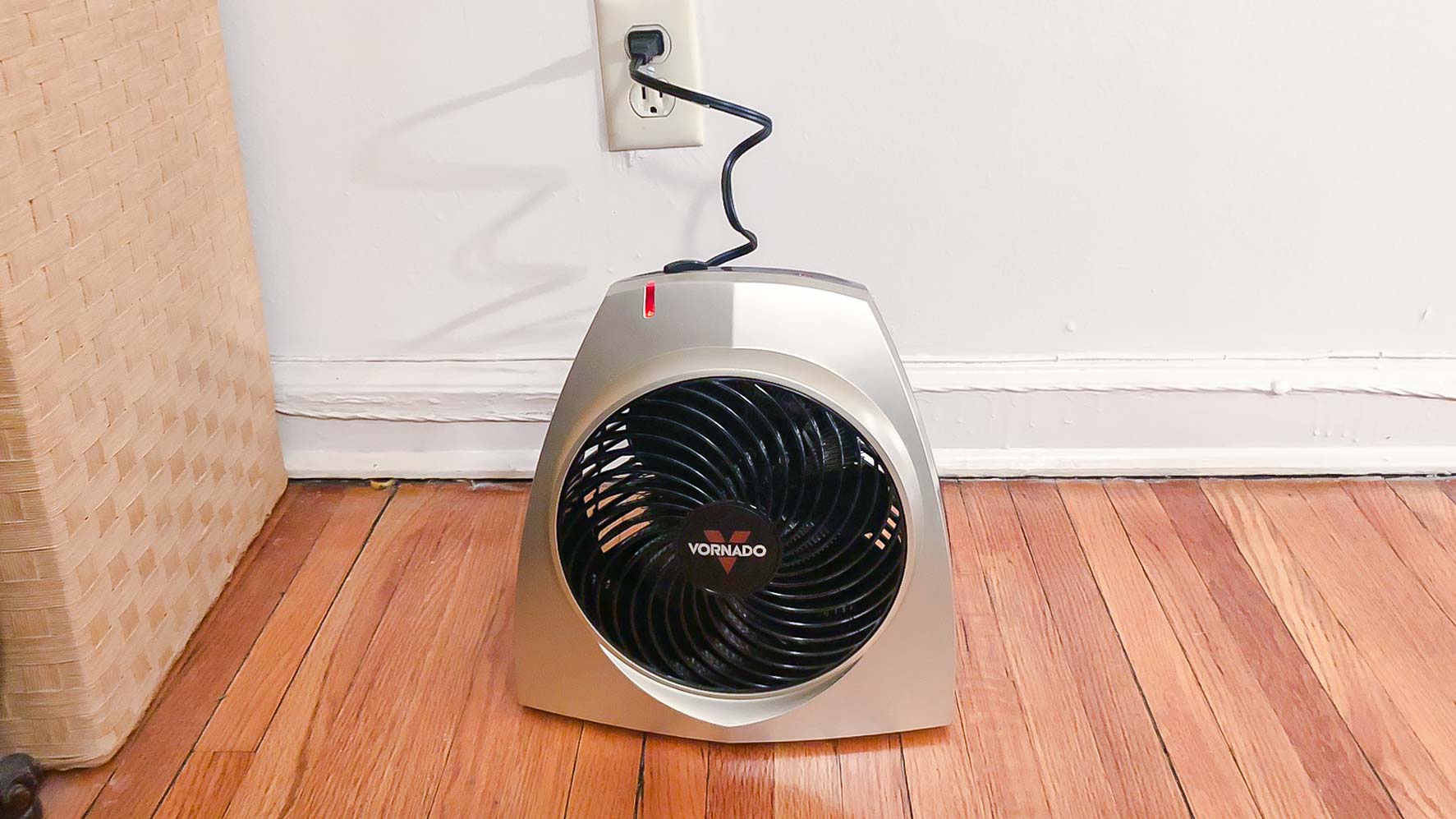
Specifications
Reasons to buy
Reasons to avoid
With its small size, silver-toned casing, and trapezoid shape, the Vornado VH200 Heater is unassuming. However, it was still able to increase the temperature of a small room by about 6 degrees Fahrenheit in just 20 minutes and provide even heating across the room.
If you place it right in front of you, you’ll feel warmer in as little as 30 seconds. The Vornado uses an average amount of energy in relation to other space heaters; about 0.26 kWh. However, once the room warms up, you can use the numbered thermostat dial to turn down the temperature and save energy.
As it's operating, all of the Vornado’s surfaces stay cool to the touch, so you don’t need to worry about accidentally burning yourself. Plus, at 45.5 decibels on high, this was the quietest space heater we tested; it sounds more or less like a humming refrigerator so it shouldn’t interfere with a phone call or a TV show.
We think the Vornado VH200 is a great choice if you’re looking for a small and unobtrusive space heater that still has the power to heat up a room. On top of that, it’s great value for the money at less than $100, which is why we think it’s one of the best space heaters around right now.
- Read our full Vornado VH200 Heater review
Best infrared space heater
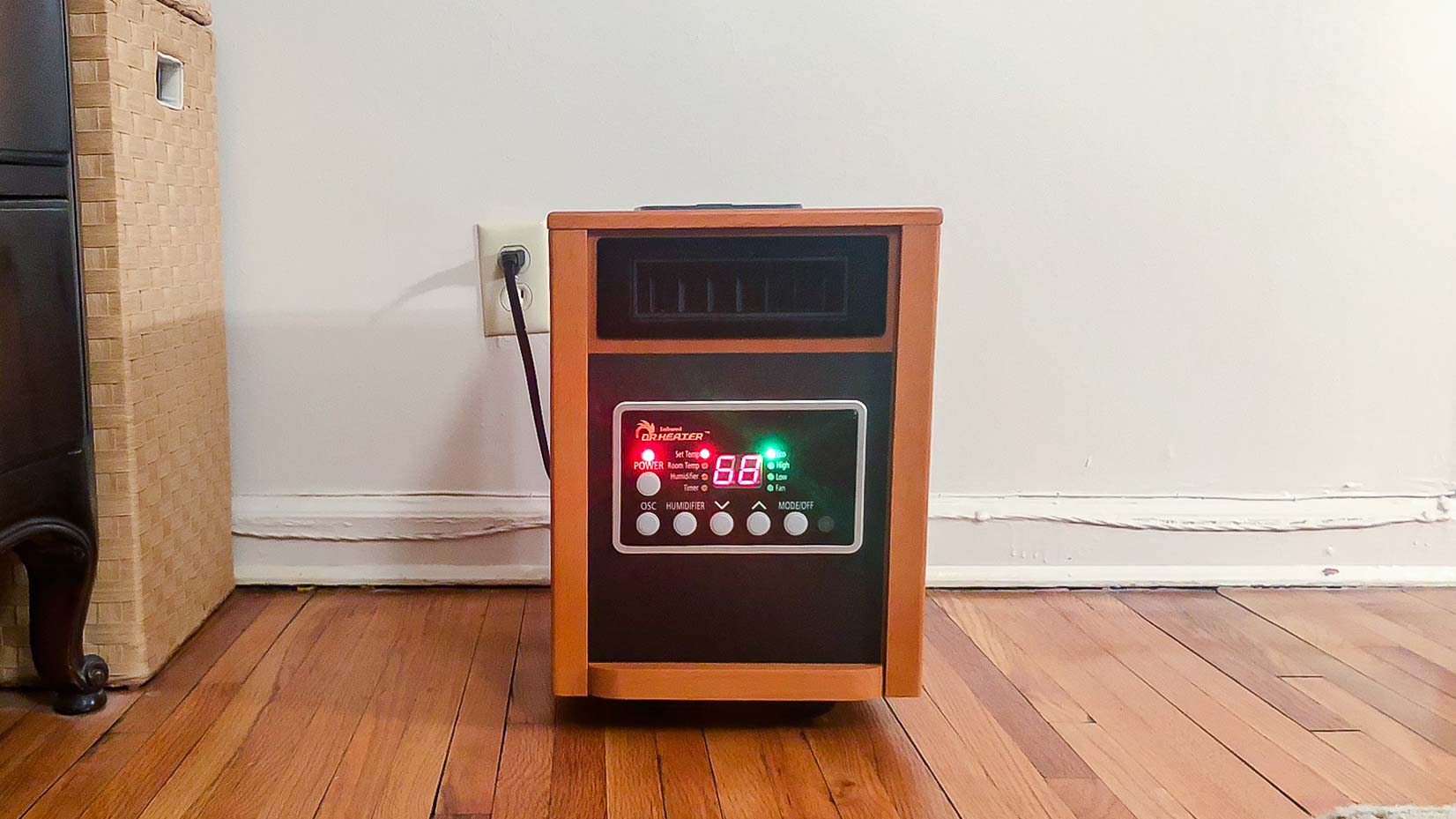
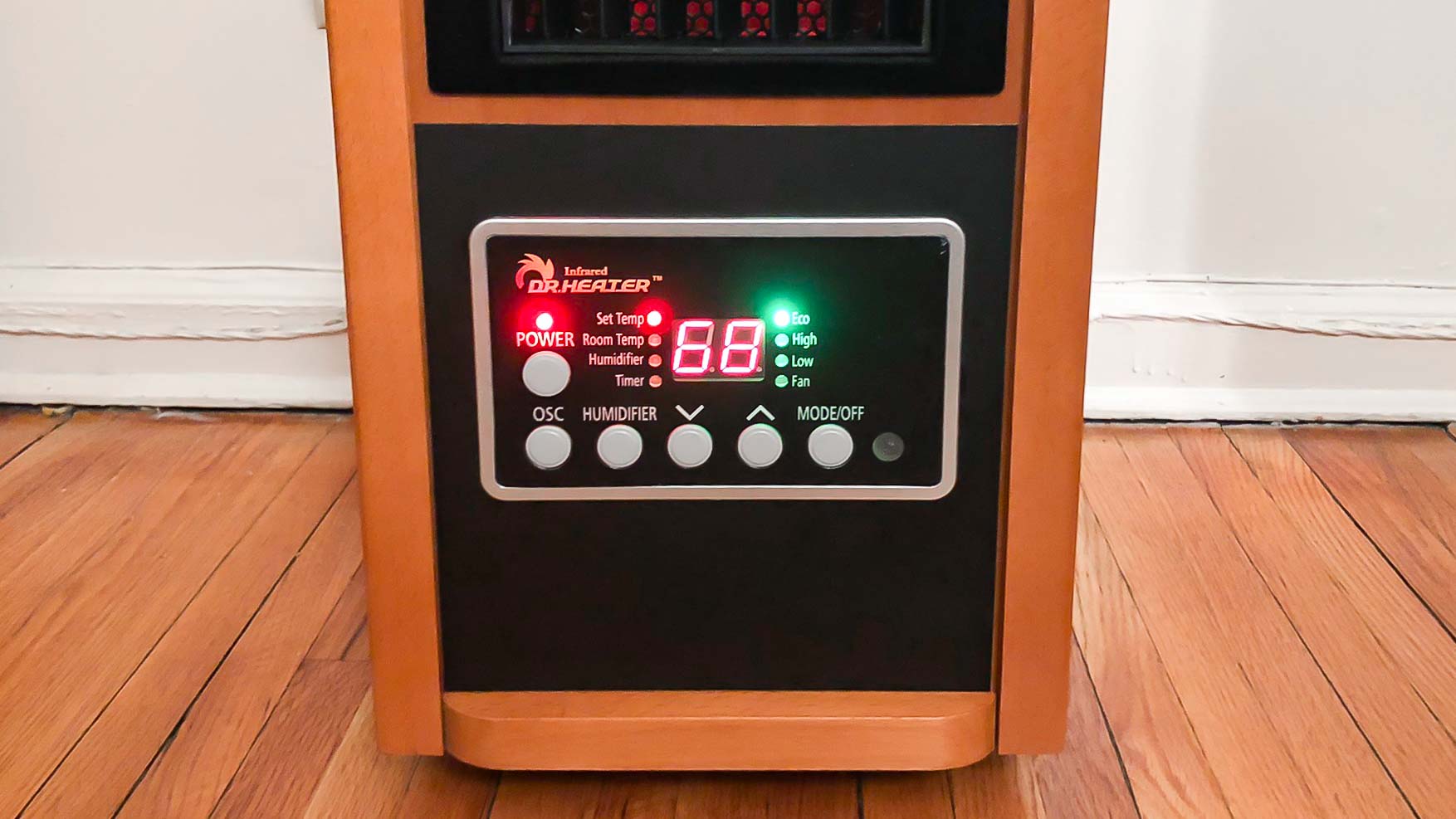
Specifications
Reasons to buy
Reasons to avoid
With its wooden casing and rectangular shape, The Dr. Infrared Heater DR-998 could be mistaken for a sub woofer speaker. It’s well constructed and looks substantial. While it would fit in well in a room with a lot of wood furniture and a warm color scheme, it might not suit every decor in the same way.
When running on a high heat setting in our 15 x 10-foot test room, it was able to increase the temperature by about 4 degrees Fahrenheit and this heat was distributed fairly evenly with just a 2 degree difference around the room, similar to most of the heaters we tested.
When placed close to where we were sitting, it was able to warm us up in under 30 seconds. This heater uses an average amount of energy compared to the other space heaters we tested.
Right on the front, it has large, well-marked control buttons and an LED display that shows the settings with easy-to-read numbers. This heater can also be used as a humidifier as well as a fan for cooling, and you can set it to oscillate up to 360 degrees for a more even distribution of air.
At 25 pounds, this is a heavy and hard-to-lift space heater. However, it has wheels that make it easy to roll across the floor or into a closet for storage. A timer allows you to set the heater to automatically turn off up to 12 hours later. To control it from across the room, a remote is included with the unit as well.
The exterior surfaces of this heater won't burn you and when it’s on its highest setting, it sounds about as noisy as a running dishwasher at 51.7 decibels, which is average for a space heater. About once a month, you’ll need to remove the filter and clean it with a vacuum and wash out the water tank.
- Read our full Dr. Infrared Heater DR-998 review
Best premium space heater
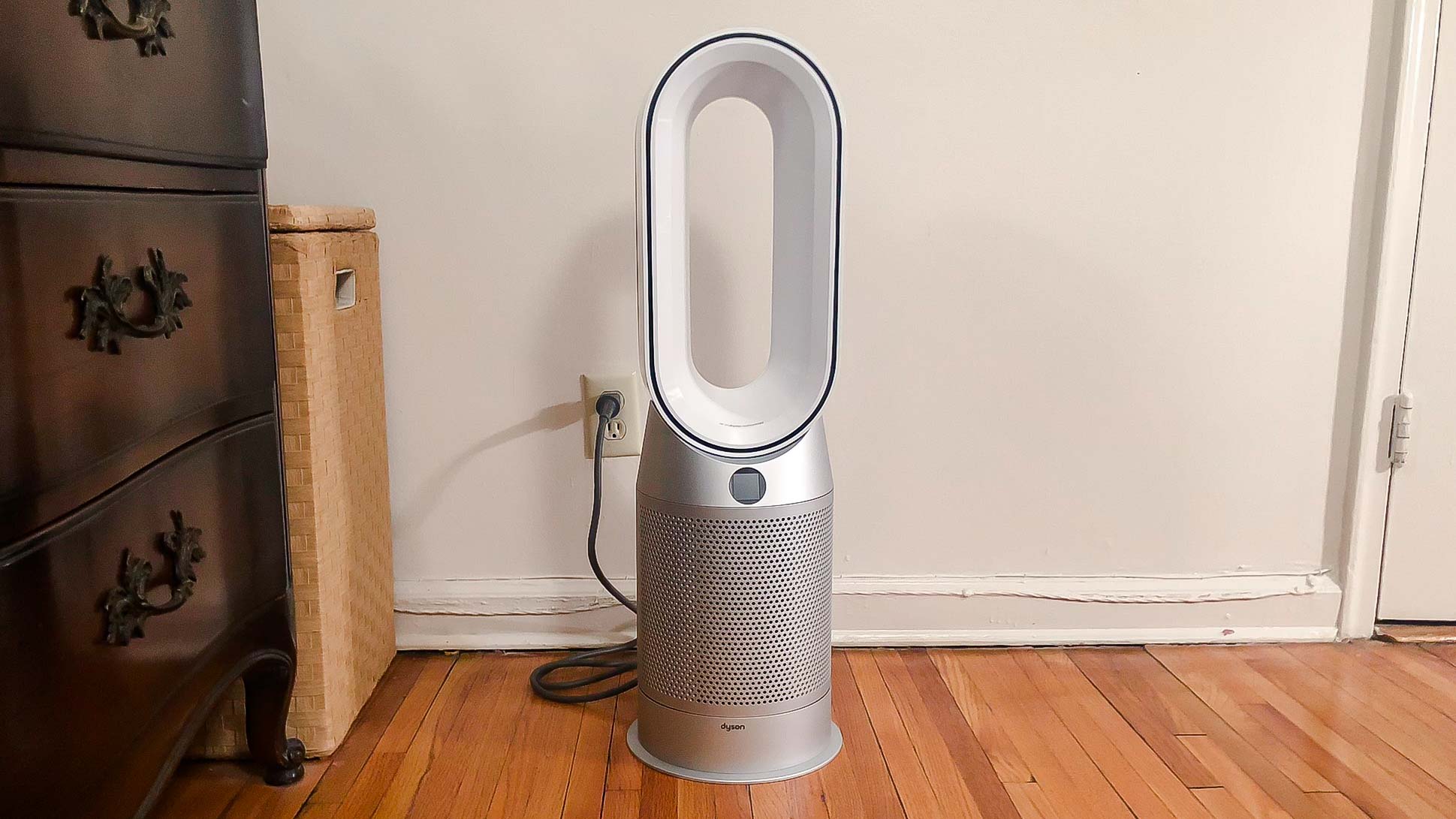
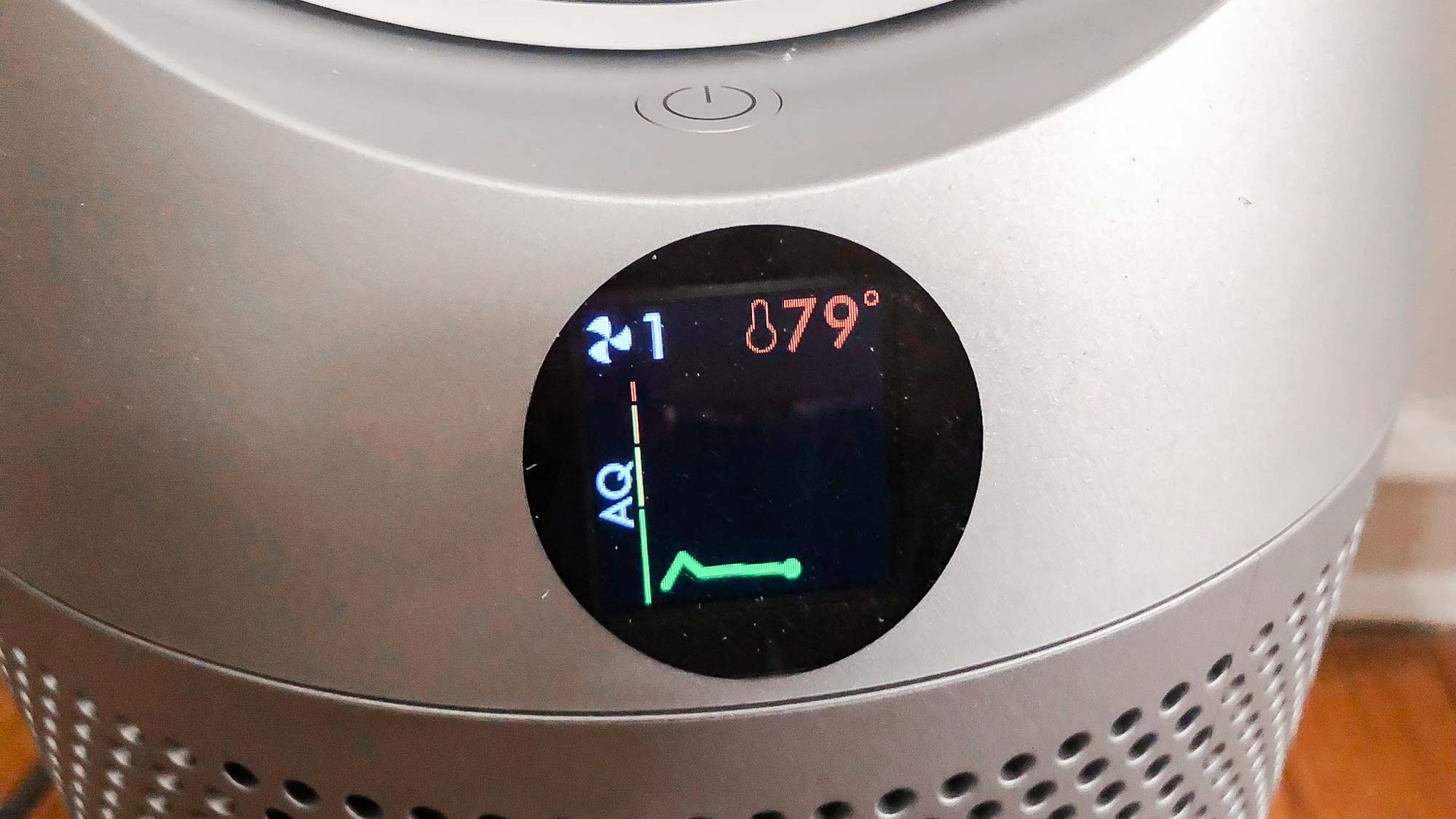
Specifications
Reasons to buy
Reasons to avoid
The Dyson Purifier Hot + Cool HP07 is way more expensive than just about any space heater on the market, but it has a lot going for it, making it one of the best space heaters.
It is beautifully designed, though its modern look may not appeal to everyone. In addition to heating, it can cool off a room and purify the air, so you are essentially getting three appliances in one.
In a 15 x 10-foot room, the Dyson Purifier Hot + Cool HP07 raised the temperature very evenly on its highest setting, increasing the temperature by 7 to 8 degrees Fahrenheit in 20 minutes. However, it used more energy than any other model we tested, an average of 0.34 kWh.
In spite of the fact that the Dyson has many functions, it's intuitive to program with the remote. In addition to changing the heat level, you can set the unit to oscillate, adjust the air flow speed and direction, set a timer, and turn on a night mode to dim the display and slow down the fan speed.
You can only operate the heating element of this appliance with the remote and if you lose it, it will cost $30 to replace. All of the surfaces on the heater stay totally cool, so there’s no chance whatsoever that anyone will get burned from touching it.
There are also no fan blades, which makes it very safe in cooling mode as well as very easy to clean. When it’s heating on high, the Dyson reaches a sound level of 55.8 decibels, which is about as loud as a coffee maker — it’s roughly the same as most of the heaters we tested.
The Dyson uses a two-piece HEPA and carbon filter to trap gasses and particles, which the company claims includes allergens, bacteria, mold, VOCs, formaldehyde, and cooking smoke and odors.
But because it’s an air purifier, you will have to replace the filter once a year at a cost of $80. By connecting the Dyson to its app, you can control the fan speed , monitor air quality, and receive alerts on your mobile device. You can also control it with Alexa, Google Assistant, or Siri.
- Read our full Dyson Purifier Hot + Cool HP07 review
Best tower space heater
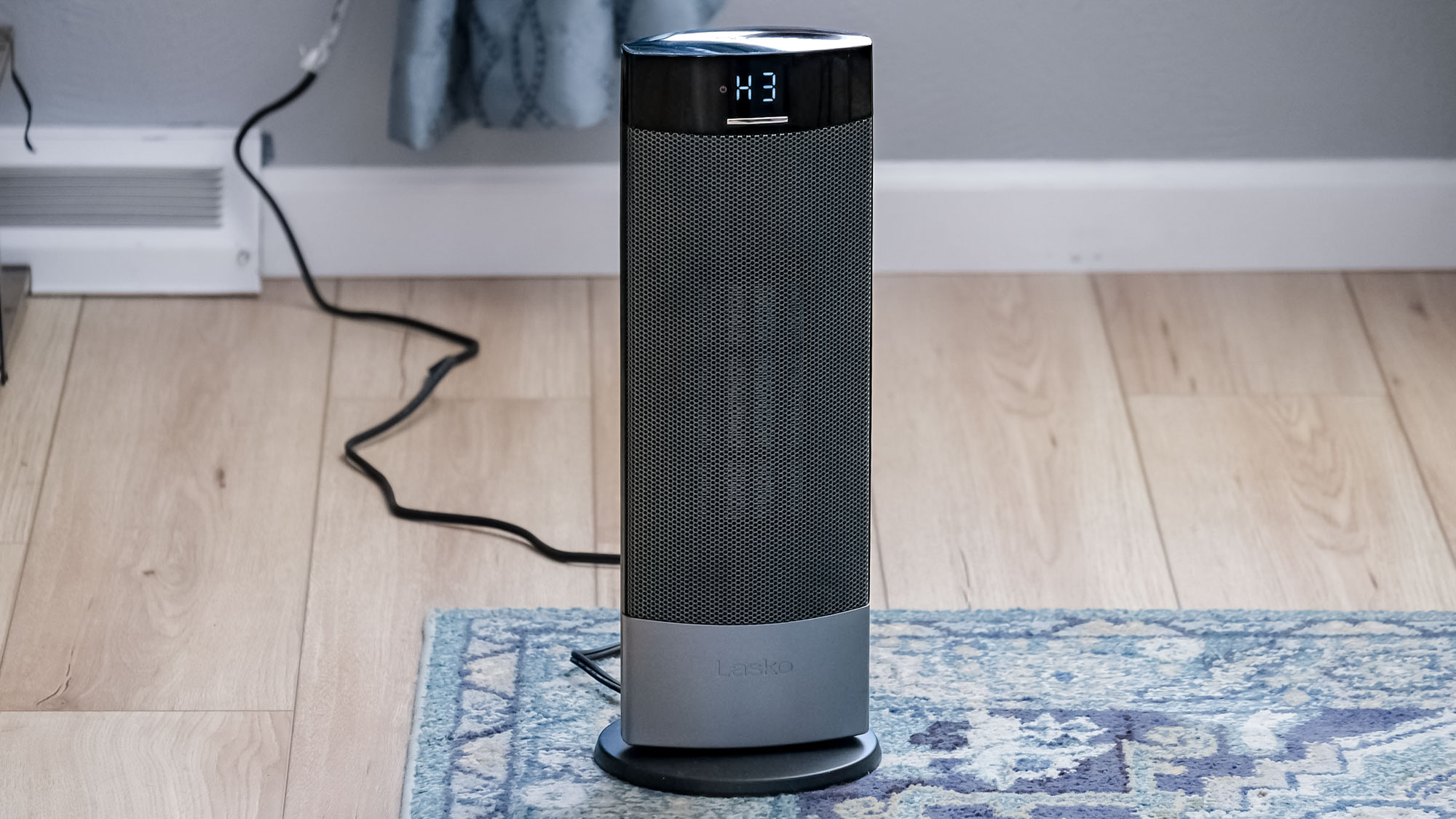
Specifications
Reasons to buy
Reasons to avoid
The Lasko Ellipse CT18950 is easily one of the best tower space heaters we've tested. It performed excellently in small and medium-sized rooms, and was able to maintain the temperature with seemingly little effort.
Partly, this is because tower units are larger and can distribute more warm air as they oscillate, but it's also due to the Ellipse CT18950's elongated design, ceramic heater and three heat settings.
The design is cool to touch, so you don't risk sudden shocks or injuries if you touch the exterior, and the digital thermostat keeps the unit running until it edges just above your target temperature, and kicks back in when it starts to drop.
Far too often, some great space heaters are let down by a terrible remote, but that wasn't the case here. The Ellipse CT18950's remote worked reliably, and was easy to use for temperature adjustments and power settings.
The overall package is good enough that it could knock the Lasko FH500 off the top spot, but that model is a hybrid fan and heater. It costs more, but not a substantial amount considering that it bundles an impressive heater and cooling fan for summer.
But if you don't need the combination model, the Lasko Ellipse CT18950 is a great option for the colder months, keeping your space warm efficiently, and it won't break the bank either; from electricity costs or the initial purchase.
- Read our full Lasko Ellipse CT18950 review
Most compact space heater
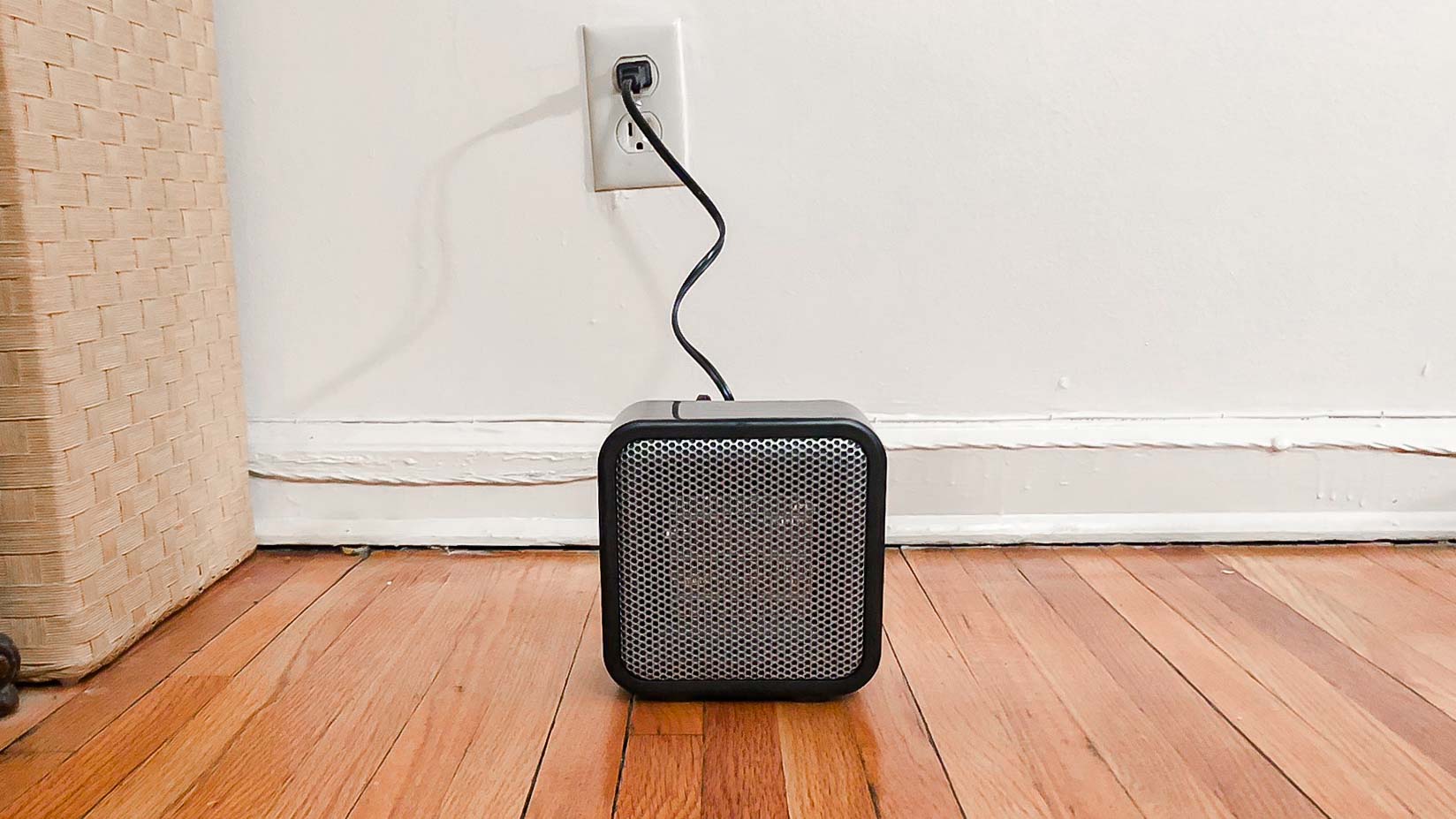
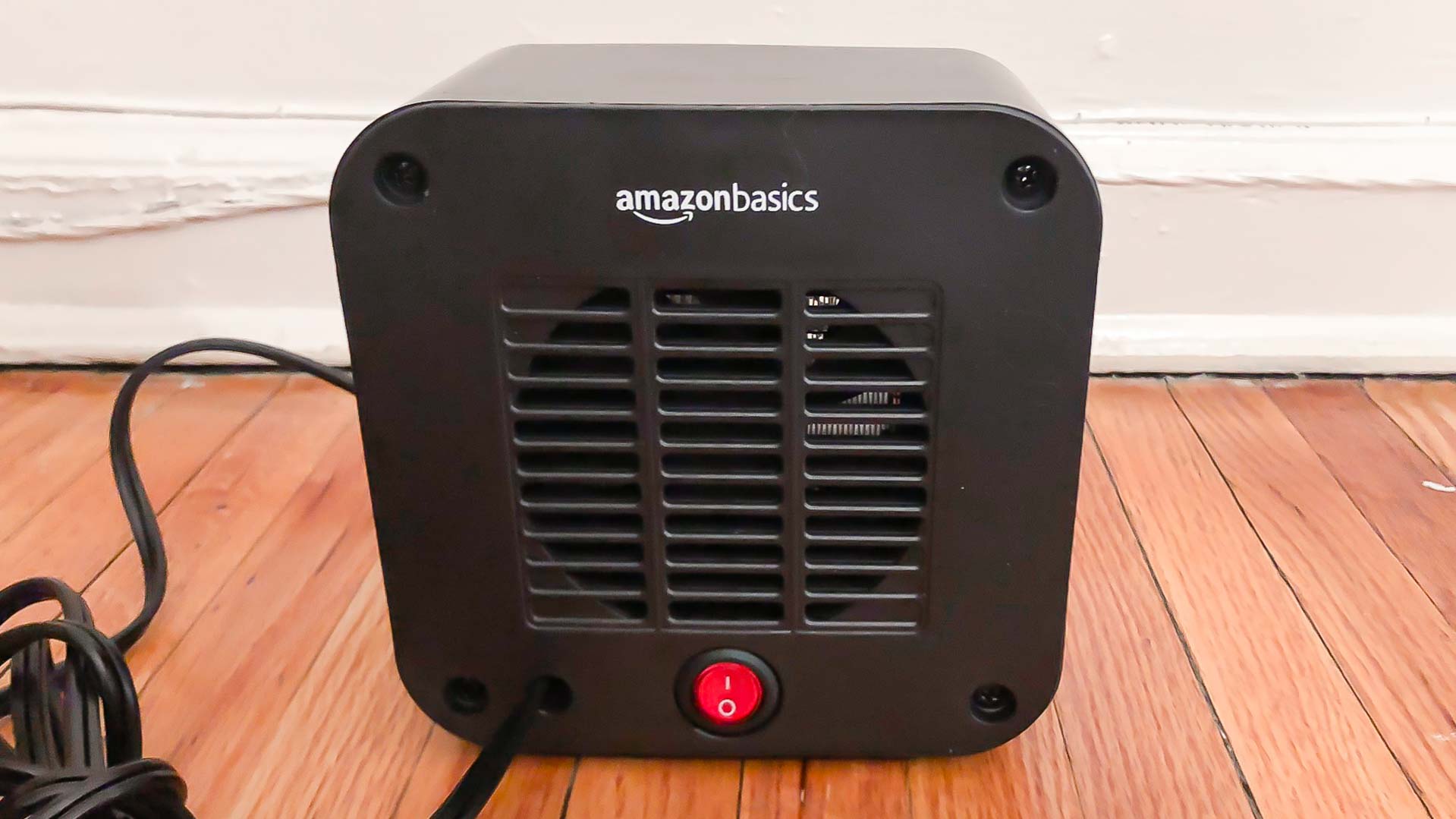
Specifications
Reasons to buy
Reasons to avoid
The Amazon Basics Small Space Heater is exactly what it claims to be — a compact heater for warming up the air immediately where you’re sitting or lounging. It’s perfect if you don’t want to spend a bundle and don’t need to warm up a whole room, but feel chilly when you’re working at your desk or reading a book.
The unit is a little box that at 5.9 x 3.2 x 6 inches is almost pocket size. In our tests, it was able to raise the temperature in our 15 x 10 foot test room evenly by only about 2.5 degrees Fahrenheit. However, when it was sitting right in front of us, it was able to warm us up by 4 degrees.
Because of its low wattage, it has the lowest energy consumption of all the other heaters we reviewed — only 0.12 kWh. This heater couldn’t be easier to use as it has just one heat setting. However, when it’s heating, it does get warm to the touch, particularly on the front where we recorded a temperature of 123°F.
We measured a sound level of 51.4 decibels, which is a tad loud for an object that will be quite close to you. At less than a pound and a half in weight, it’s easy to tote from room to room and it’s so small that it won’t take up much room in a closet when it’s not being used — it could even be stashed in an office desk drawer.
- Read our full Amazon Basics Small Space Heater review
Best space heater for small spaces
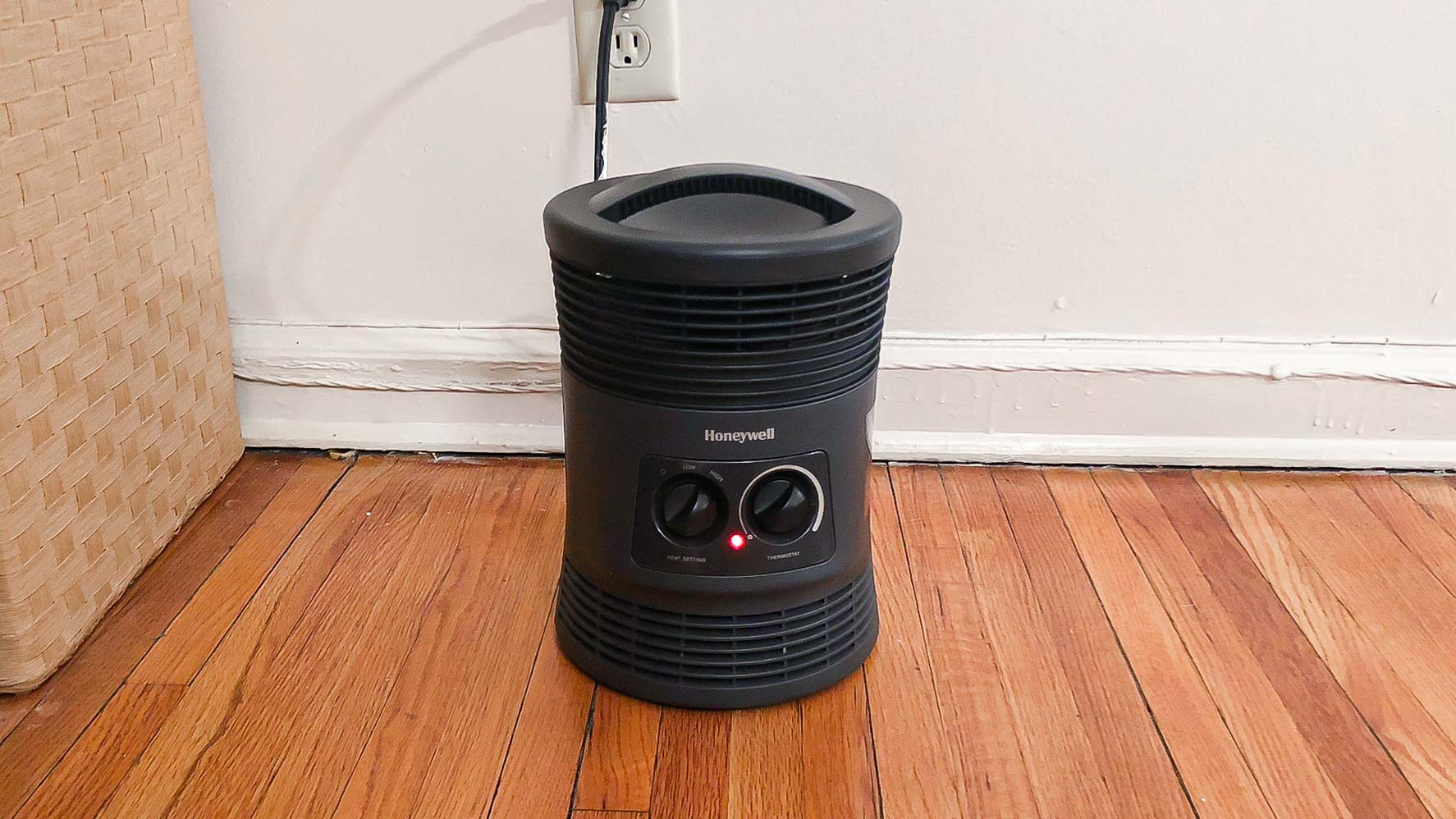
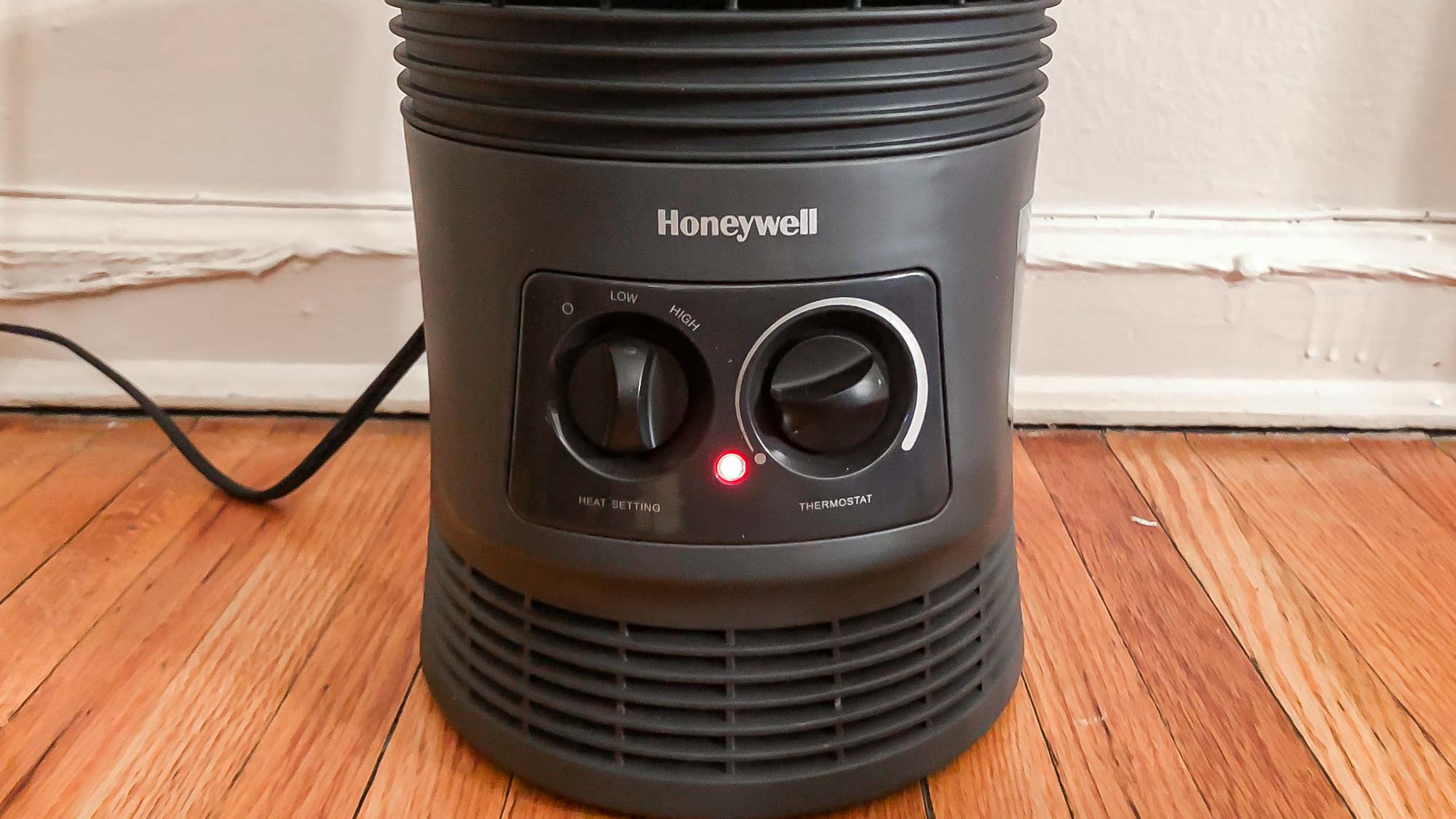
Specifications
Reasons to buy
Reasons to avoid
The Honeywell 360 Degree Surround Heater is a no-nonsense model for heating a small area. It’s perfect if you’re looking to take the chill off when you’re working at a desk or hunkered down on the couch.
On its high heat setting, the Honeywell 360 Degree Surround Heater was only able to get a 15 x 10-foot room 2 to 5 degrees Fahrenheit warmer (depending on where you stood) and didn’t heat particularly evenly.
However, when it’s right beside you, it will heat you up in 10 seconds. It uses an average amount of energy when heating, 0.25 kWh. With only two buttons and two heat settings, the Honeywell is easy to set. Once it heats up, there’s a variable thermostat that you can use to stabilize the temperature.
As it operates, the surfaces of the unit heat up by about 10 degrees above room temperature, but it’s nowhere near enough to be a burn hazard. At 59.9 decibels, this was the loudest space heater we tested, so it’s not ideal if you’re trying to watch TV while it’s running.
On top of the unit there’s a handle that makes it very convenient to move around, and at 5.4 pounds it’s pretty lightweight. This heater is a good value for what it brings to the table, which is why it makes the list as one of the best space heaters, but you should only use it in smaller rooms.
- Read our full Honeywell 360 Degree Surround Heater review
Best wall-mounted space heater
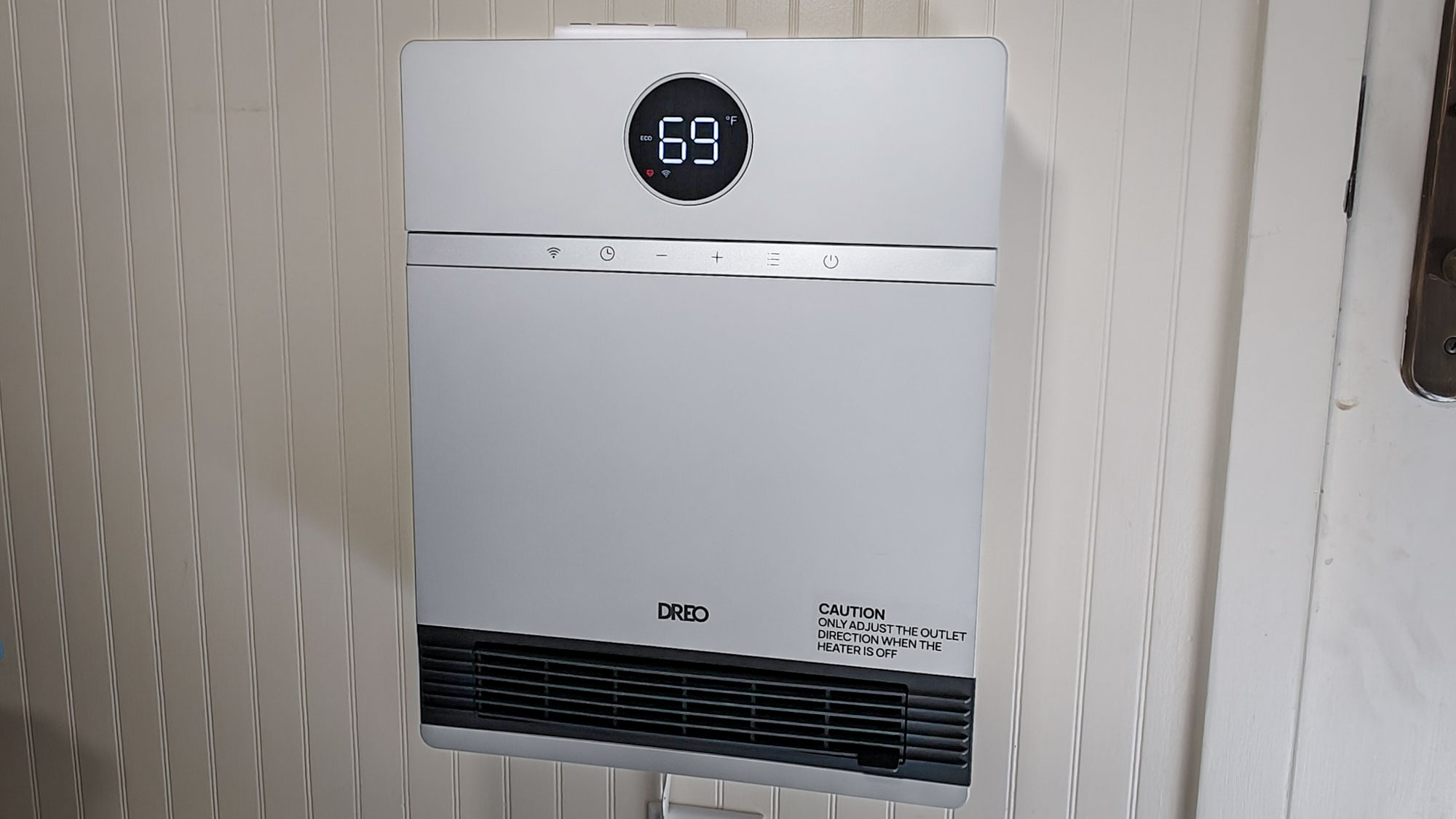
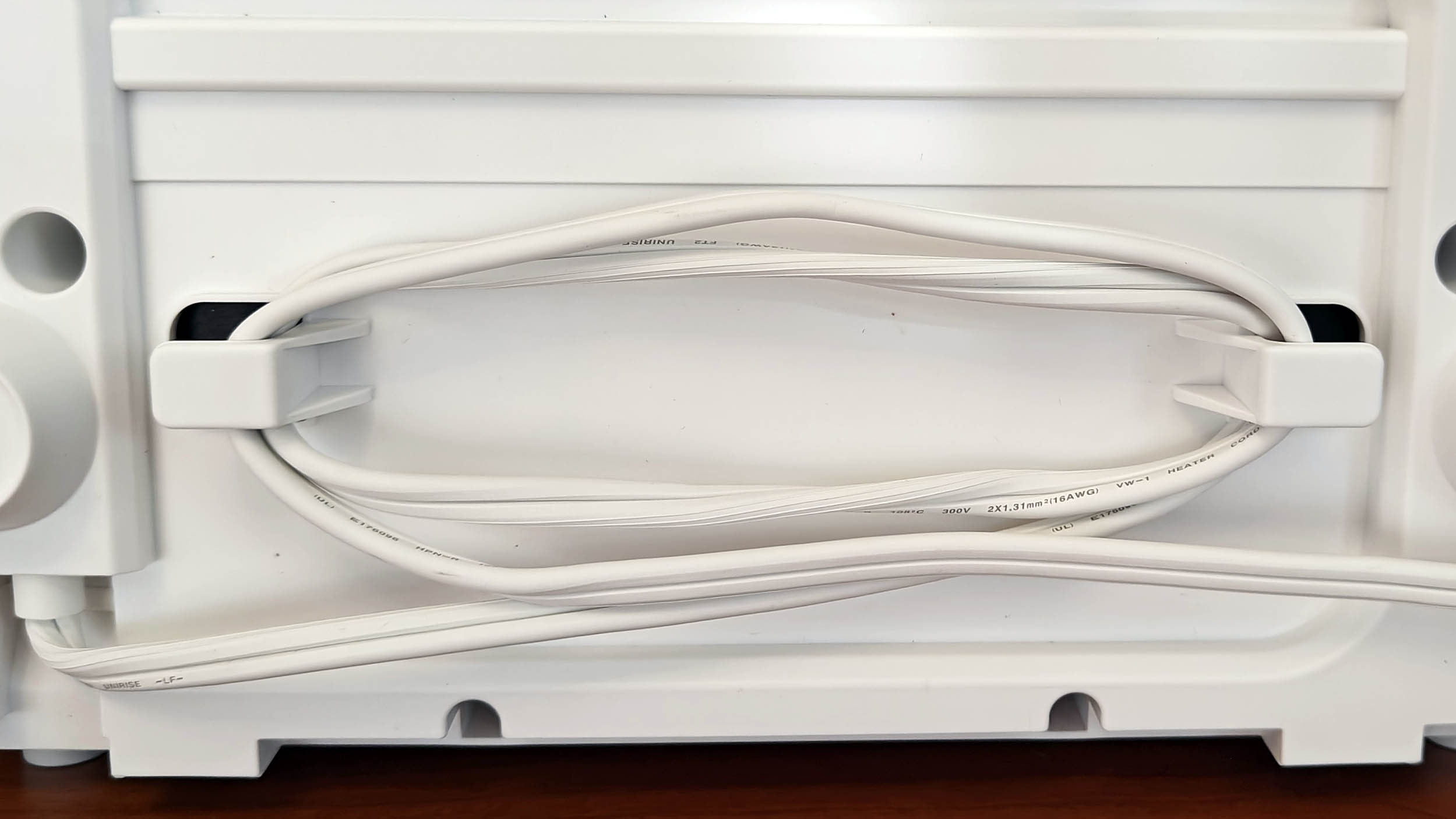
Specifications
Reasons to buy
Reasons to avoid
If you want a space-saving yet powerful heater, the Dreo Smart Wall Heater is a great option. Firstly, it's easy to mount on the wall and has a stylish, discreet design that won't look out of place.
It comes with adjustable louvers for directing the air to where it’s needed and it’s simple to adjust the heater with its panel, remote control, Dreo app or with voice commands via Alexa or Google Assistant. With more than enough warming potential for the average, mid-sized room.
We tested all four heating modes (including Eco) and were impressed at how rapidly the Dreo circulated heat around the room. It particularly worked well in our tester's 150 square foot hallway where the temperature can drop below 45 degrees Fahrenheit during winter.
Another great feature was the Dreo app, which has a simple interface and is straightforward to use. We were able to check the heater’s status and temperature from upstairs, across town and even several states away.
At 44.9 decibels, this isn't the quietest space heater we tested, however, it isn't loud enough to disturb the peace. And the fact that it's on the wall means that you can pretty much set and forget that it's even there. On that note, this is wall-mountable only, so you can't move it from room to room, without installing again.
Priced under $100, this heater is great value for its fast heat output and handy smart features. Best suited for mid-sized rooms.
- Read our full Dreo WH517S Smart Wall Heater review
Best heat pump
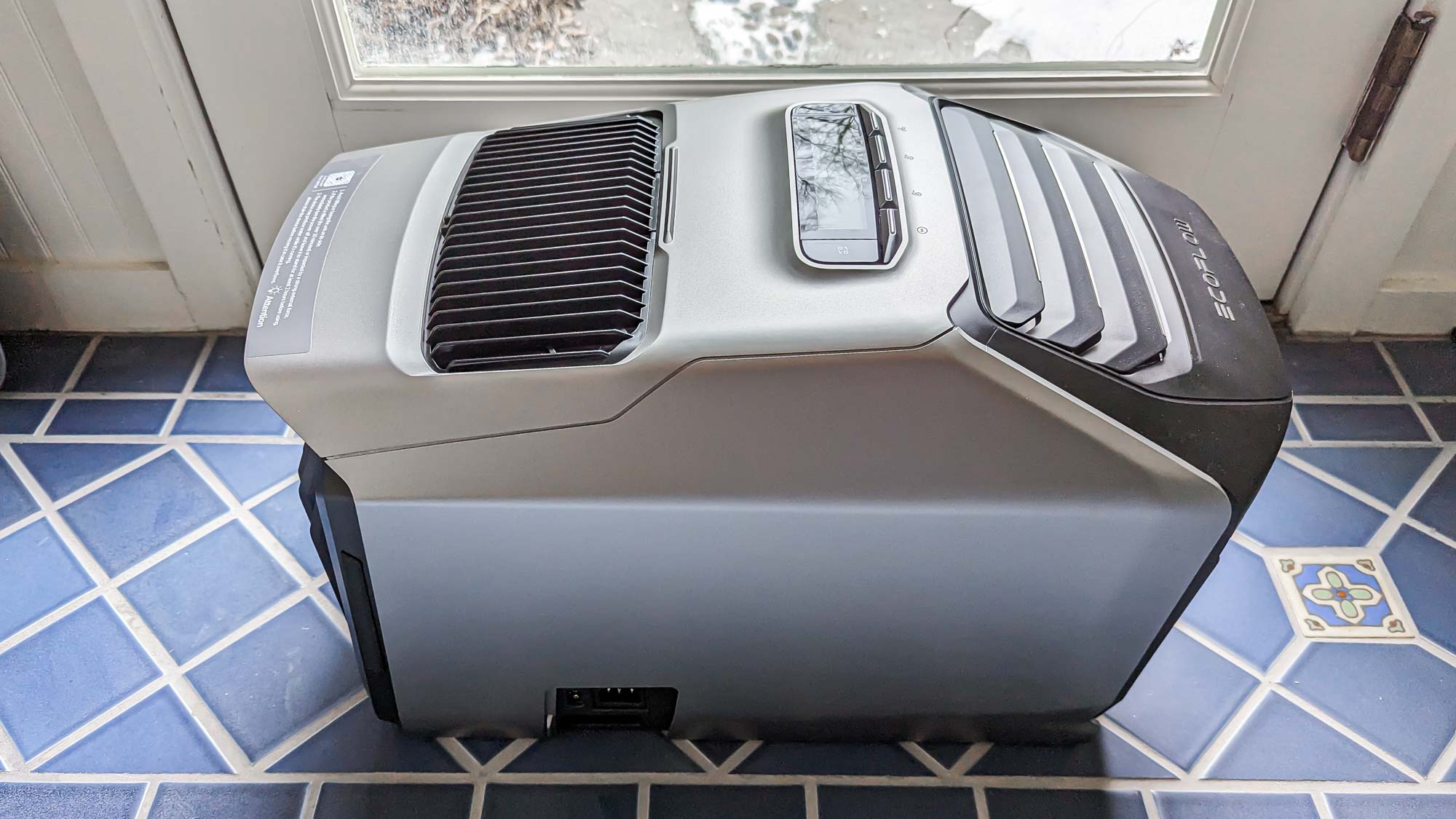
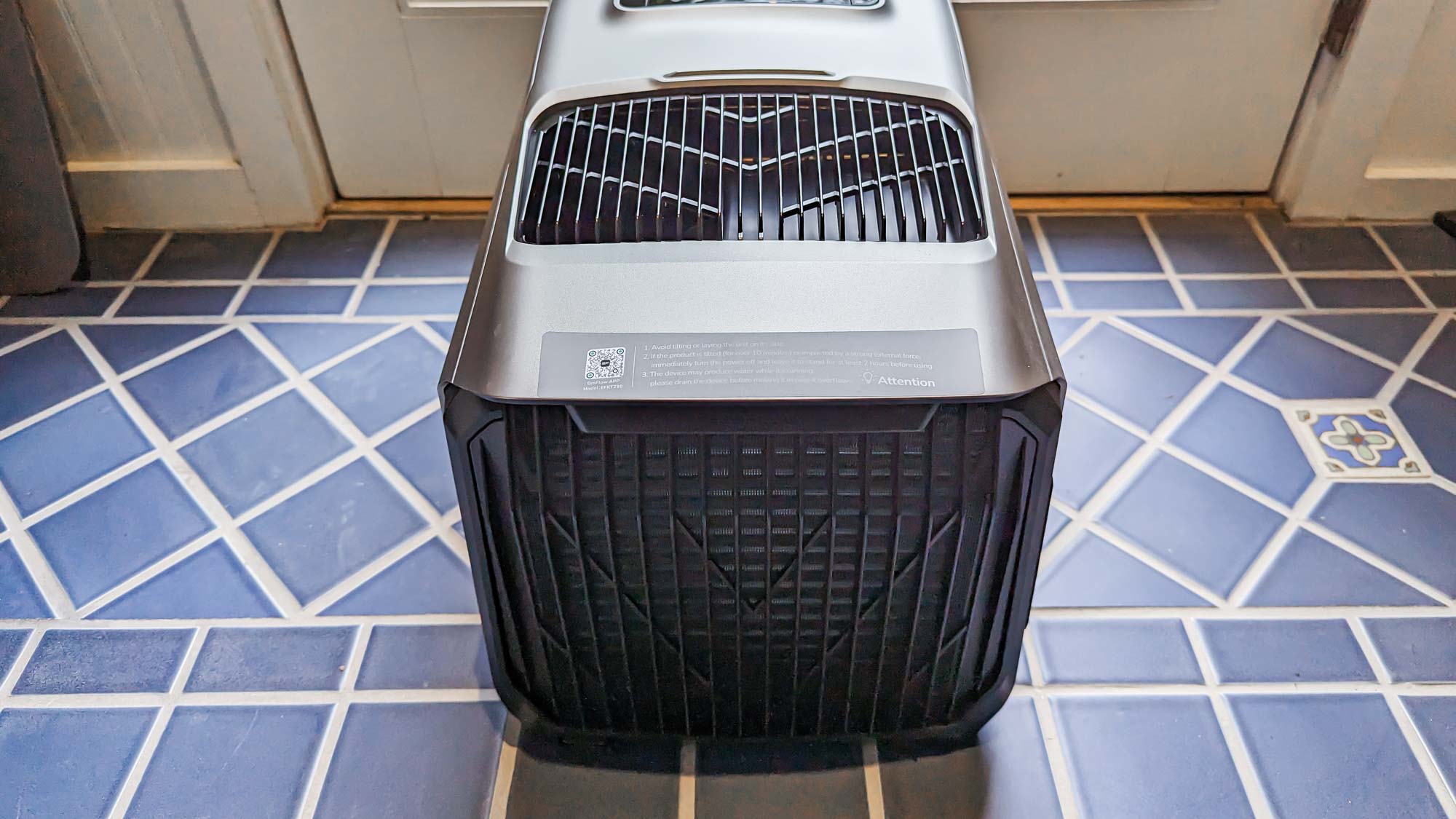
Specifications
Reasons to buy
Reasons to avoid
The EcoFlow Wave 2 isn't cheap — at $1,300, it's by far the most expensive space heater on this list. However, unlike every other model here, the Wave 2 can also act as a smart air conditioner, combining two devices in one.
The Wave 2 is a heat pump: to warm you up, it compresses a gas in a closed loop, which generates heat, which is then blown into your room. To cool things down, it allows the gas to expand, which has the opposite effect. It's capable of heating a room at up to 6,100 BTUs per hour and cooling it at 5,100 BTUs per hour. That's good enough for a 110-square foot room.
The Wave 2 can be controlled using a touch panel or through the EcoFlow app, which we found very easy to use; unlike many space heaters, we could fine-tune the temperature controls, and even create schedules for it to turn on and off.
While you can plug the Wave 2 into an outlet, it can also be paired with a battery or solar panel if you want to use it off the grid, which makes it well suited for those living the van life.
During use, we found that the Wave 2 effectively heated and cooled various rooms in our home, and did so efficiently — it consumed 4.3 watts of power when idle and 536 watts when heating — and was a quiet 57.2dBA when warming our room. So, this is a pricey investment, but one that could be worth it over the long haul.
- Read our full EcoFlow Wave 2 review
Also tested
We test many more space heaters than we recommend in our main roundup and only suggest the models we genuinely think are the best space heaters. But that doesn't mean the others we try are bad. So, if you're after more options here are the space heaters that didn't quite make the cut.
Pelonis 16-inch Space Heater
This is a great option for smaller rooms. We were pleased with how well it heated the space, but the remote control is next-to useless. Still, if you want a heater to put on and leave in smaller rooms, it's a good choice.
Read our full Pelonis 16-inch Space Heater review
Heat Storm Phoenix Infrared Space Heater
This is a versatile heater, as you can place it on the floor or mount it on the wall. But while it was good at heating, it wasted some energy heating the floor, making the Dr. Infrared Heater DR-998 a better choice if you're after an infrared model.
Read our full Heat Storm Phoenix Infrared Space Heater review
Vornado VHEAT Whole Room Vintage Heater
If you're after something that's a bit more stylish than the usual metal box design, this is the one to go for. But it's hard to recommend for performance; it's loud and not as efficient as models that cost about half the price.
Read our full Vornado VHEAT Whole Room Vintage Heater review
How we test the best space heaters
To test heating performance, we time how quickly each space heater can heat up the air directly in front of it. We also measure the temperatures either side within a 15 x 10 foot room after each heater has operated for 20 minutes on its highest heat setting — this is to check for evenness and consistency.
For accuracy, we time how long each space heater takes to significantly boost the room’s temperature, and we do this from two distances. While doing this, we take the floor’s temperature to check how much heat is wasted.
Using an energy meter, we track the energy used on the minimum and maximum heat levels to determine the energy efficiency. We then measure five different surface temperatures on each heater as well as the floor in front of it to see if there was a burning hazard, or if the appliance wastes energy heating the floor.
In addition, we run the appliance on its highest setting to test the noise output, and measure the space heater’s external temperature to ensure against burning hazards. We also take into account added safety features, including tip-over protection and automatic shut-off.
How to choose the best space heater for you
Space heaters vary in size, heating ability, features, and price. The most expensive ones look better and can do more than just heat — they can also cool off a room and may even be able to humidify or purify the air. However, they’re also larger and less portable.
Safety Features: When you buy a space heater, start by checking that it bears the UL, ETL, or CSA International insignia which tells you that it has been tested and certified by a third party organization.
In addition, make sure it will shut off automatically if it tilts, tips, or overheats. One heater we tested — the Lasko 754200 — lacks this feature, which is why it didn’t make the list of the best space heaters. Any heater that you consider purchasing should have a sturdy cord that is at least six feet long.
Heating Capacity: The wattage of a space heater is an important factor in determining how large an area it will warm up. Generally, a heater needs 10 watts of power to heat each square foot of space.
That means to heat up an average-sized room, you’ll want at least a 1,500-watt heater. But take into the account the height of your ceilings and the level of insulation in the room, as this will have a reflection on the area that will need heating and how much energy will escape.
Fan: To distribute heat quickly, look for a model with a fan. An oscillating fan helps disperse heat more evenly.
Thermostat: A space heater that has a thermostat allows you to fine tune the temperature and keep it at a level you find comfortable. An electronic thermostat with precise temperature settings will give you the best control.
Often manufacturers refer to the thermostat as an eco setting as it saves energy by only using as much power as needed to keep a steady temperature.
Other features to consider: A timer that will automatically shut the heater off is handy as you won’t have to worry about whether or not you remembered to do it. Remote controls are also useful.
With a remote controlled model, you can turn the heater on and off without putting your book down or tearing yourself away from the TV. If you plan to use the heater in various rooms, you’ll find a handle makes it easy to carry.
Still unsure if a space heater is right for you? Check out should you buy a space heater? Here are the pros and cons.
Tips for using a space heater safely
- Place your space heater on a flat stable surface like a hardwood floor. Do not use it on carpet.
- Never use an extension cord or power strip with a space heater. They’re not designed to accommodate the power needs of a space heater and can overheat, leading to a fire.
- Inspect the cord regularly to make sure it isn’t damaged or frayed in any way. If it is, stop using it immediately.
- When you’re not using a space heater, unplug it.
- Don’t go to sleep with a space heater switched on.
- Never leave a space heater unattended while it’s operating. If you leave the room, turn the heater off.
- Don’t cover a space heater with clothing or a blanket and keep it away from curtains, beddings, and papers.
- Be vigilant about keeping children and pets away from the unit and its power cord at all times.
FAQs
How much should you spend on a space heater?
Depending on the size and functionality, space heaters can cost anywhere from $20 up to $700, so you really should have a budget in mind before you start browsing. Generally speaking, the more versatile the machine is, the more it will cost.
So any additional functions, such as humidifiers or air purifiers, will only add to the price tag, although you do technically get two appliances in one here. With that in mind, only invest in multifunctional devices if you intend to use the extra features.
Some models can function as fans as well as space heaters, which makes them useful throughout the year, for example. Make sure you check the energy consumption as well — otherwise your space heater can cost you an arm and a leg to run over time.
We recommend considering your budget before shopping as well as what you need from your space heater in terms of size and functionality. That way, you can prevent overspending.
Do space heaters dry out the air?
No, although it may seem as though the air is dryer. Space heaters increase the air temperature which increases the amount of water air can absorb, making the atmosphere appear drier.
This is because warm air can hold more moisture than cold air, which makes the room feel drier, however, moisture isn’t being removed as it would be when using a dehumidifier.
How long should you run a space heater?
Ideally, it's advised to only run space heaters for a few hours, and should never be left running overnight. This is mainly due to fire risk safety, and to avoid the risk of it toppling over or overheating.
However, you should opt for space heaters with a thermostat, or safety features such as automatic shut-off if they get too hot. These will all minimize the risk of a potential fire.
When should you replace your space heater?
While there are estimates that a space heater can last anywhere from 16 to 20 years, how long one actually stays in good working order depends on how much it’s used. If you see the cord is damaged or fraying or notice sparks or odd smells from the heater or the outlet, stop using it immediately and replace it with a new one.
Other signs that it’s time to buy a new model include ceramic panels that are cracked, broken or have eroding finishes. When you shop for a new space heater, you’ll find the latest models are more attractive so they will look less obtrusive sitting in your family or guest room.
Many space heaters now have electronic controls and some even come with a remote so that you can turn them on and off without leaving your desk or the sofa. You can now also find space heaters that double up as fans, humidifiers, or air purifiers so that you get more for your money.
Get instant access to breaking news, the hottest reviews, great deals and helpful tips.

As the Homes Content Editor, Cynthia Lawrence covers all things homes, interior decorating, and garden-related. She has a wealth of editorial experience testing the latest, ‘must-have’ home appliances, writing buying guides and the handy ‘how to’ features.
Her work has been published in various titles including, T3, Top Ten Reviews, Ideal Home, Real Homes, Livingetc. and House Beautiful, amongst many.
With a rather unhealthy obsession for all things homes and interiors, she also has an interior design blog for style inspiration and savvy storage solutions (get rid of that clutter!). When she’s not testing cool products, she’ll be searching online for more decor ideas to spruce up her family home or looking for a great bargain!
- Sharon Franke
- James FrewBuying Guide Editor
